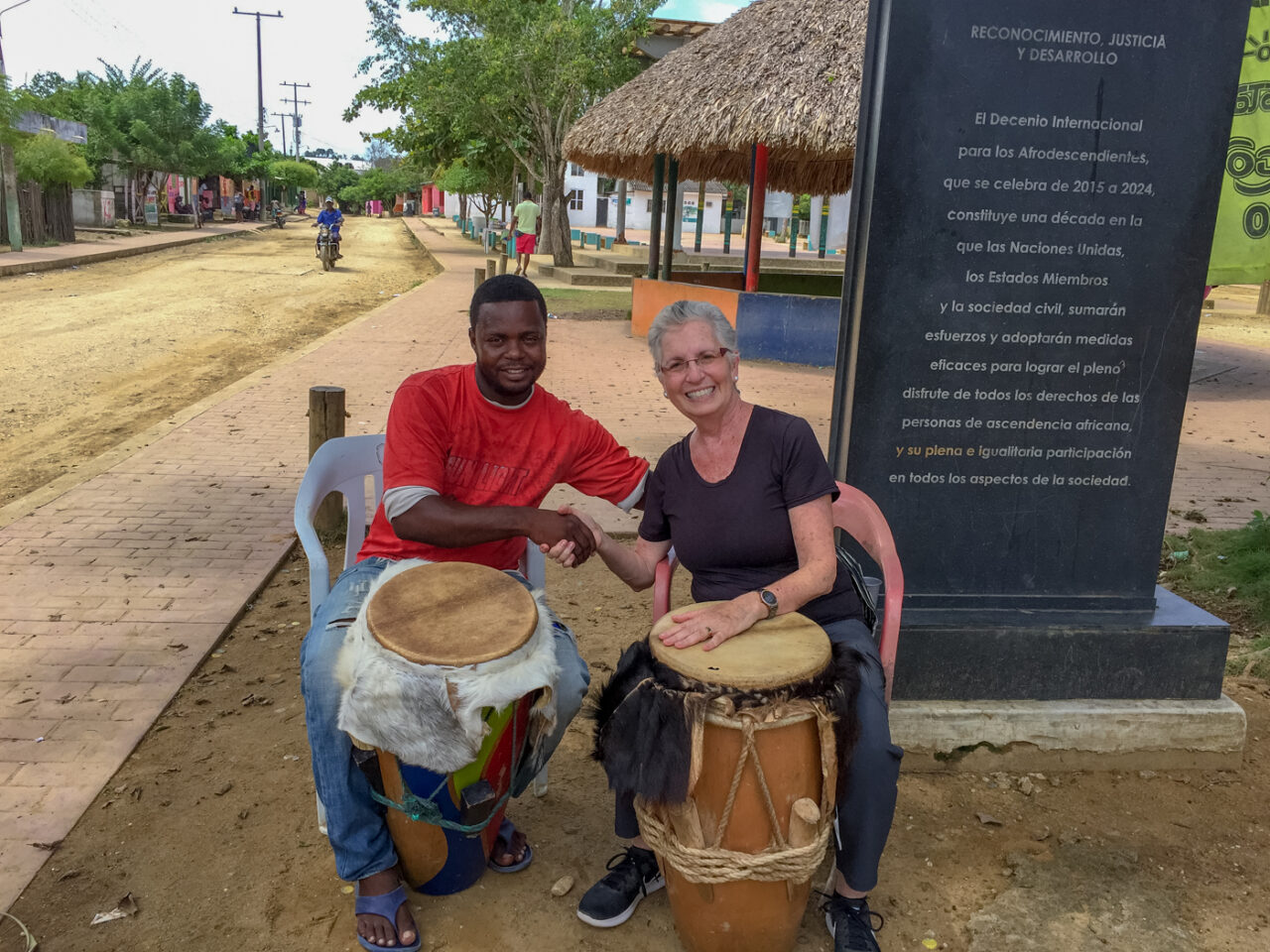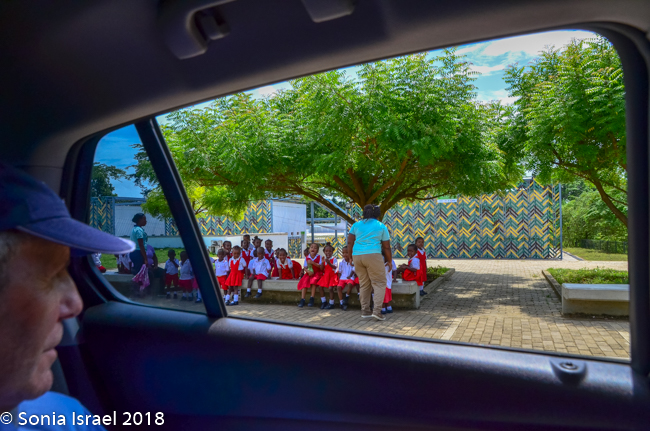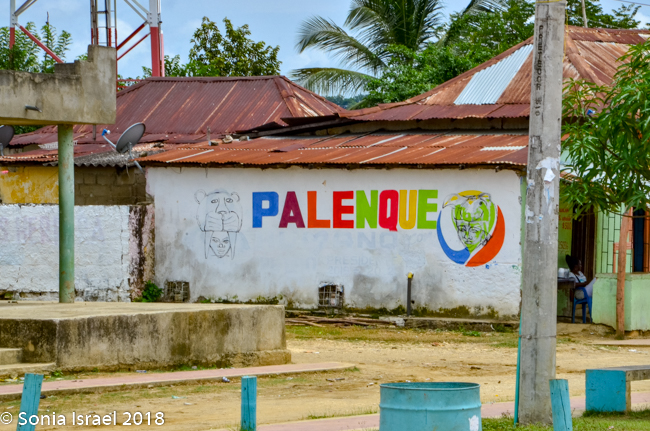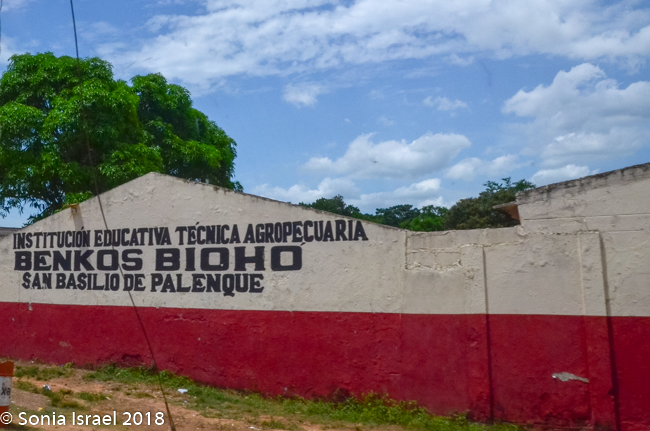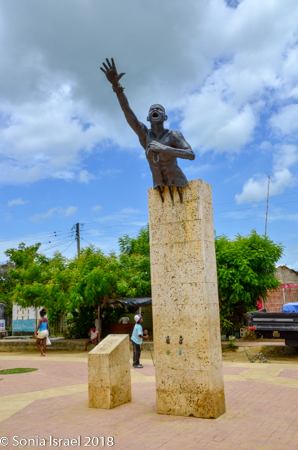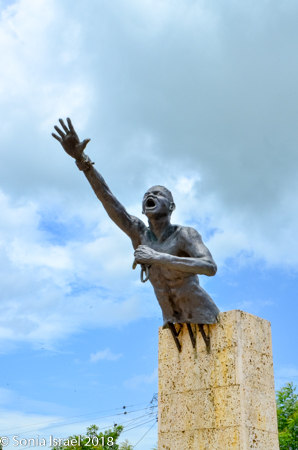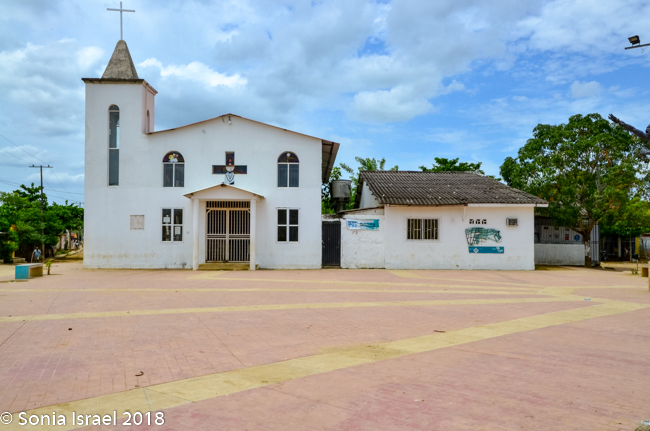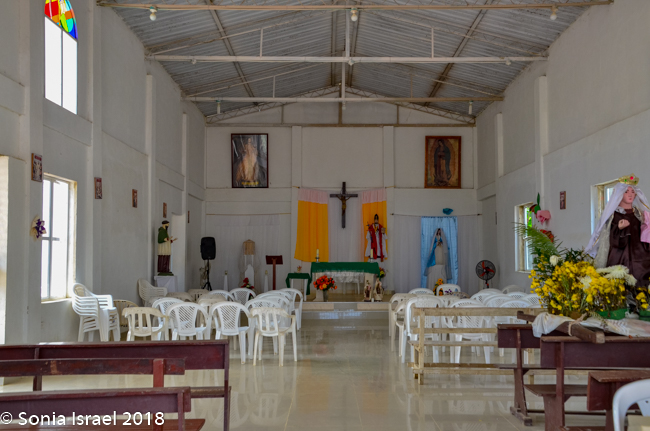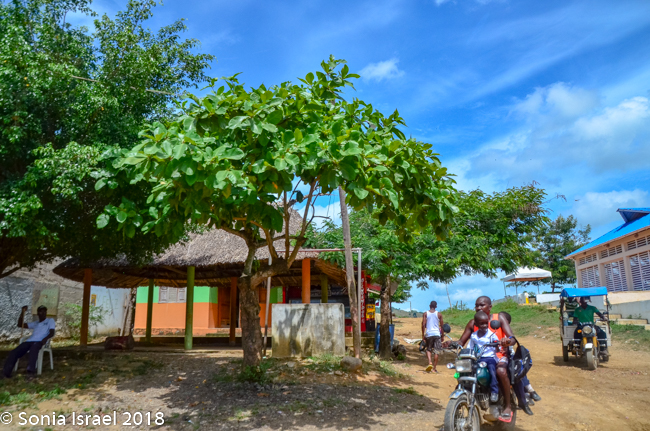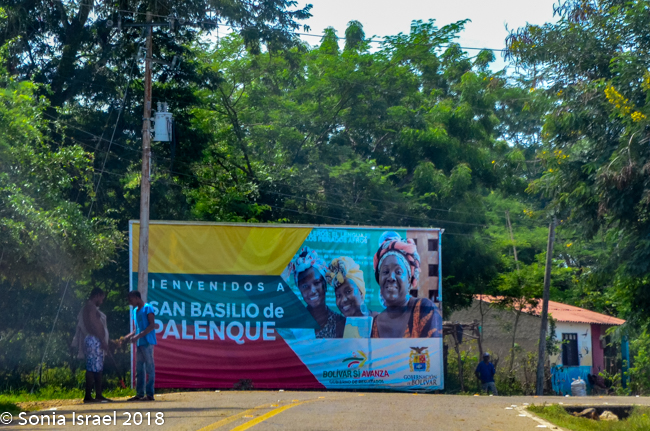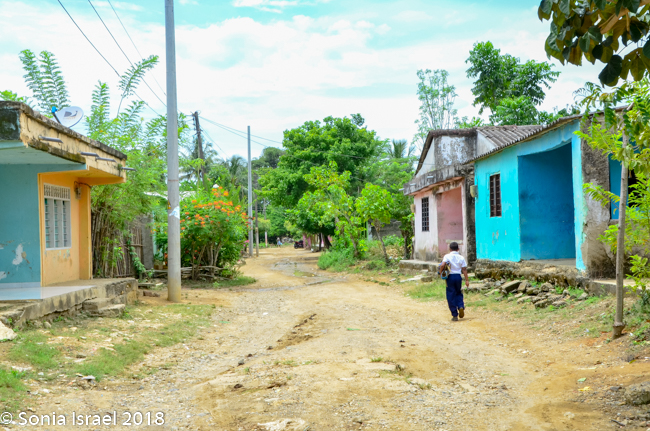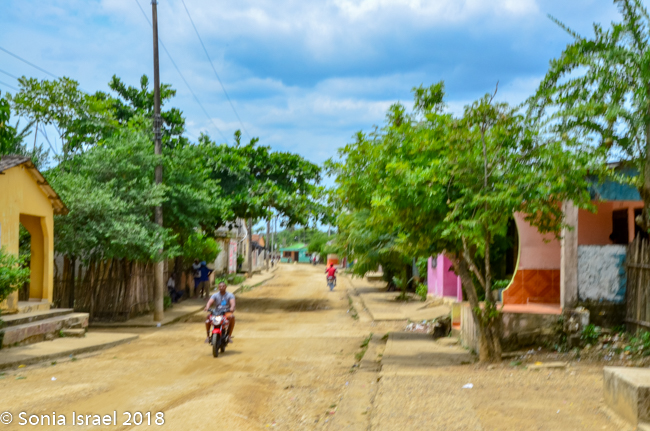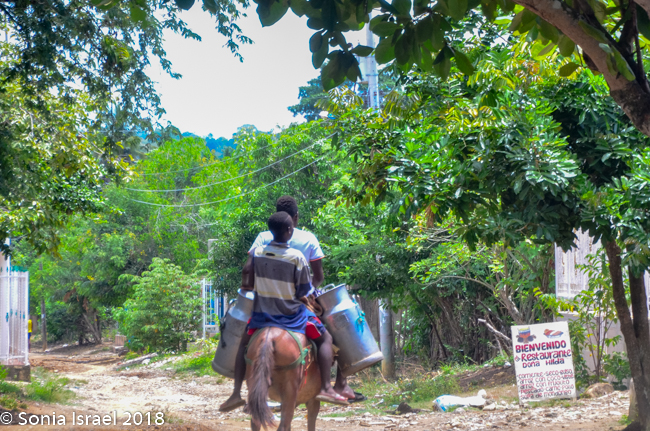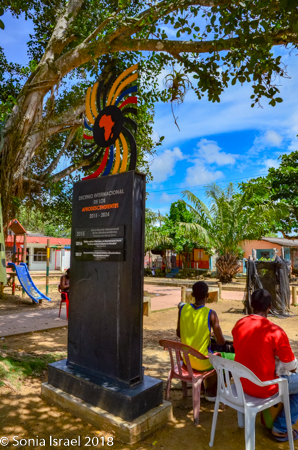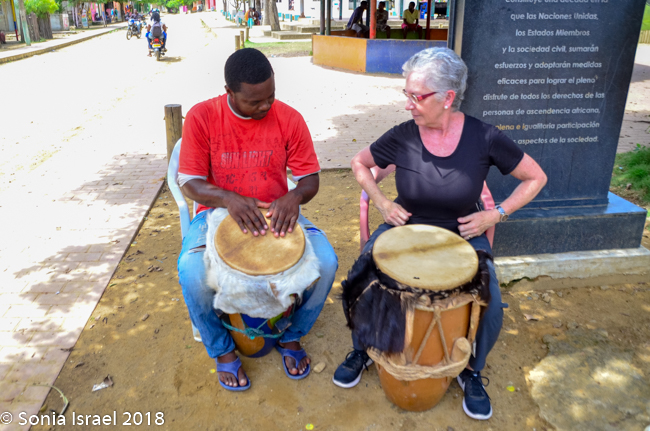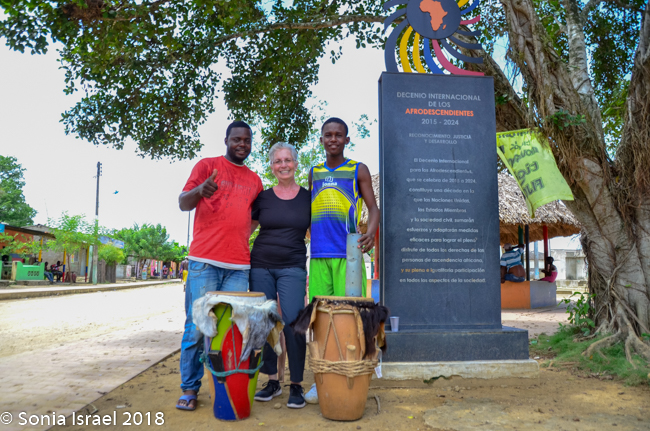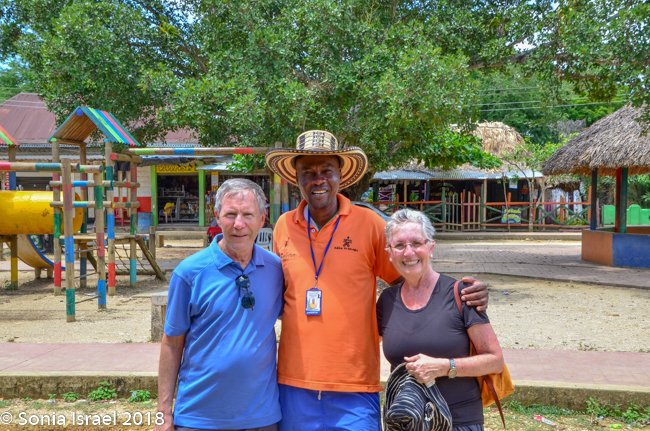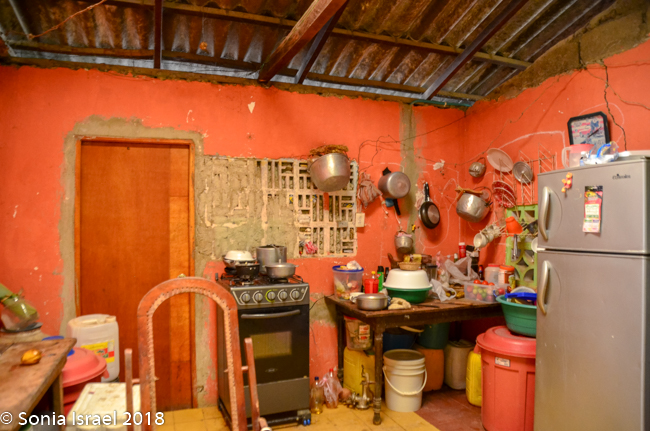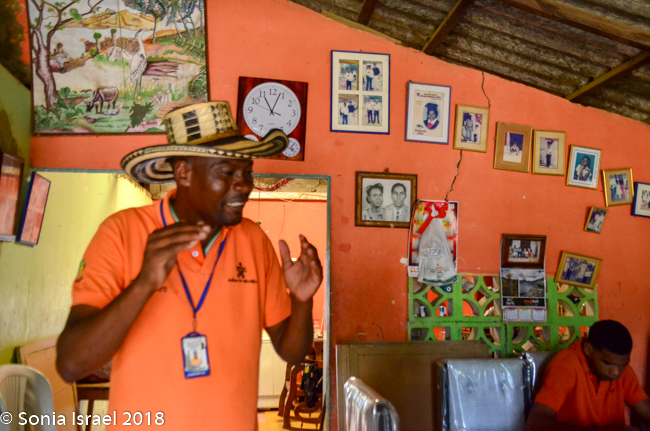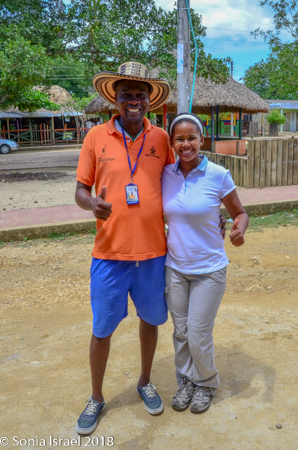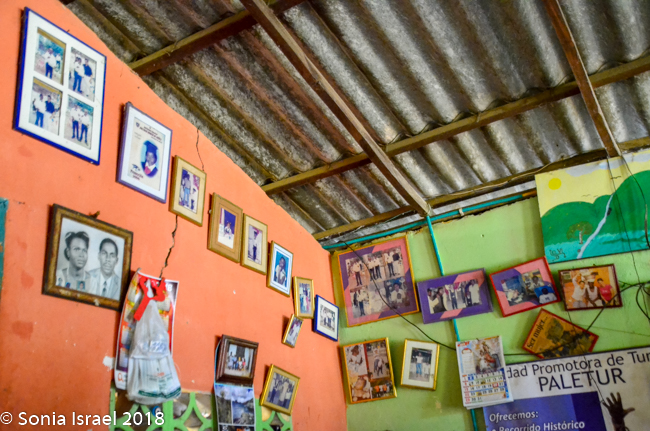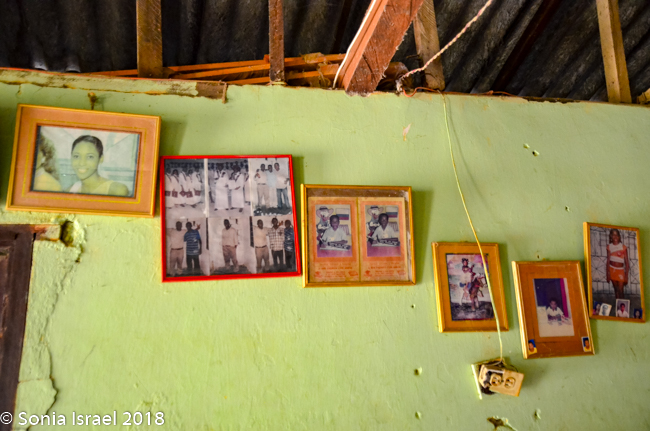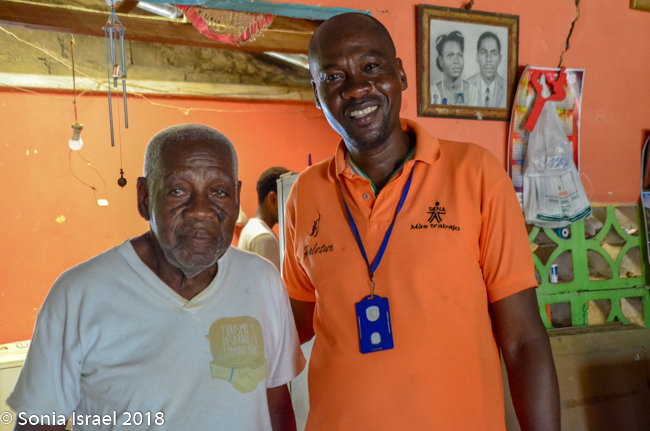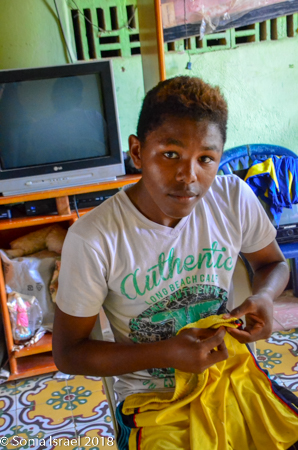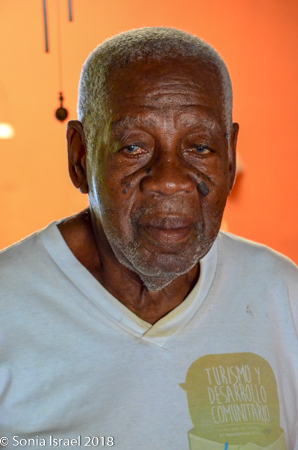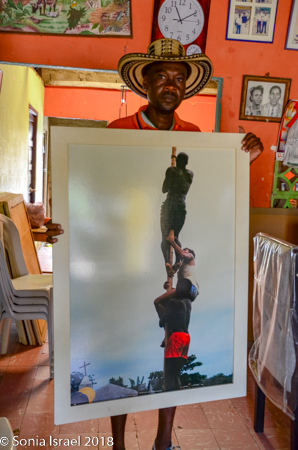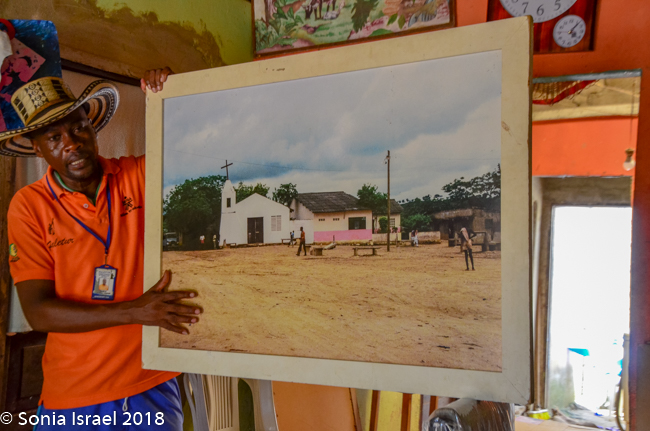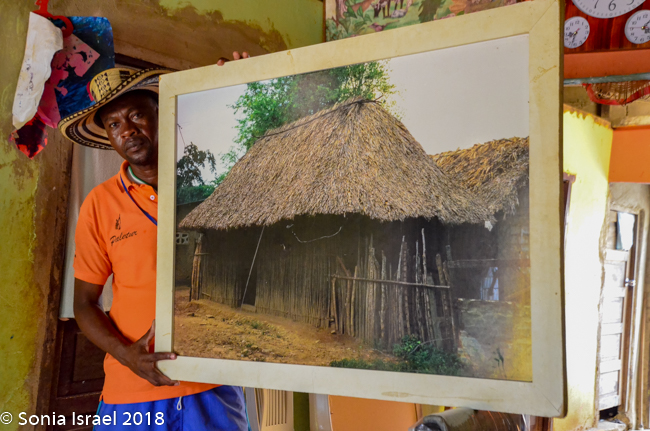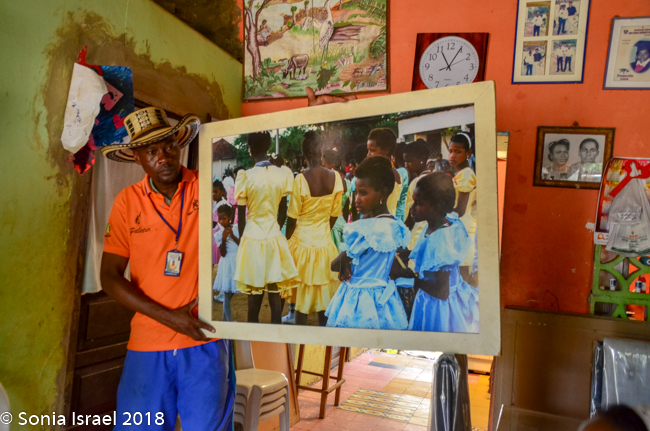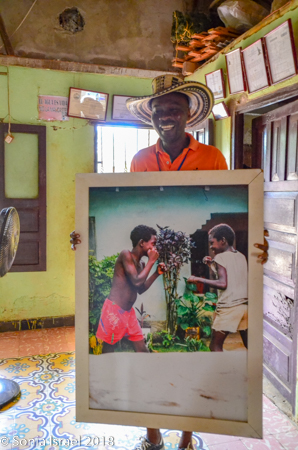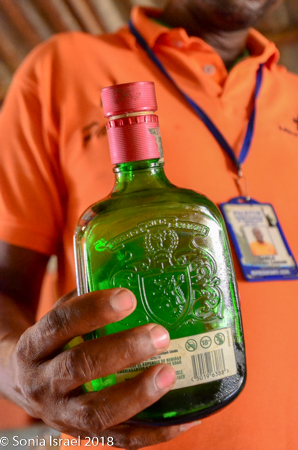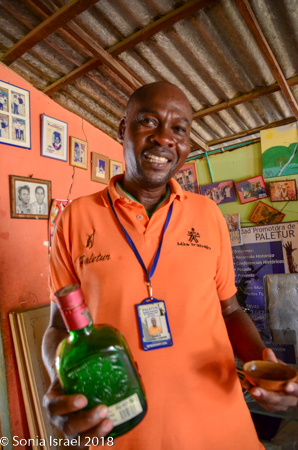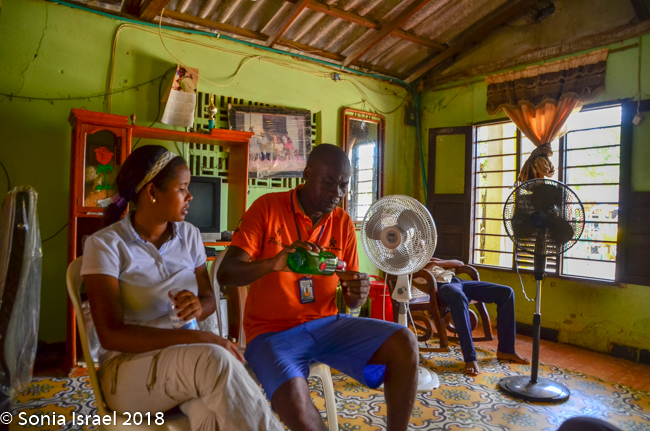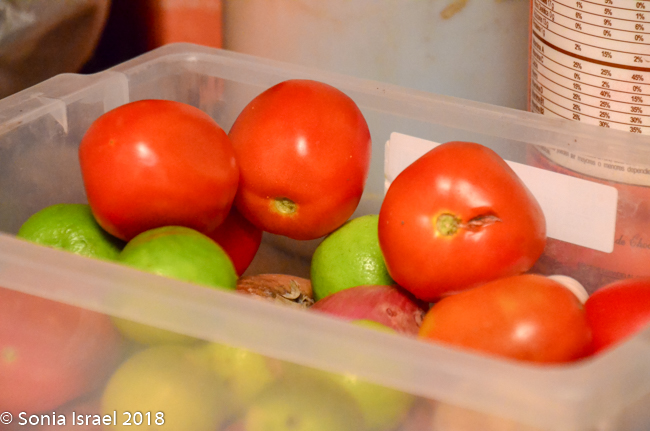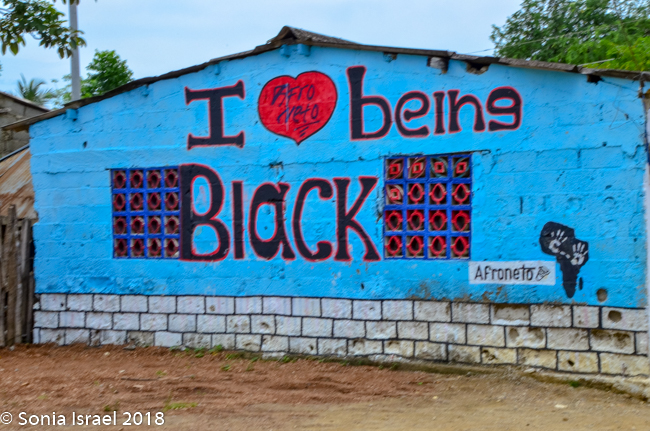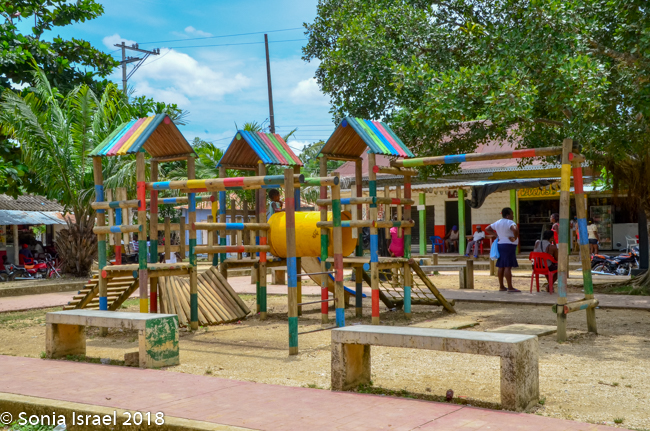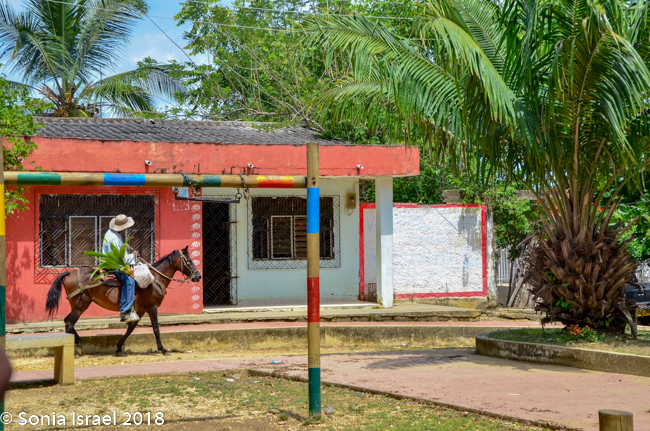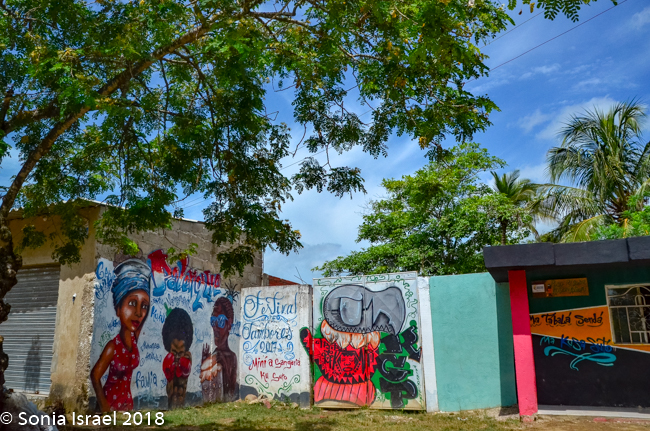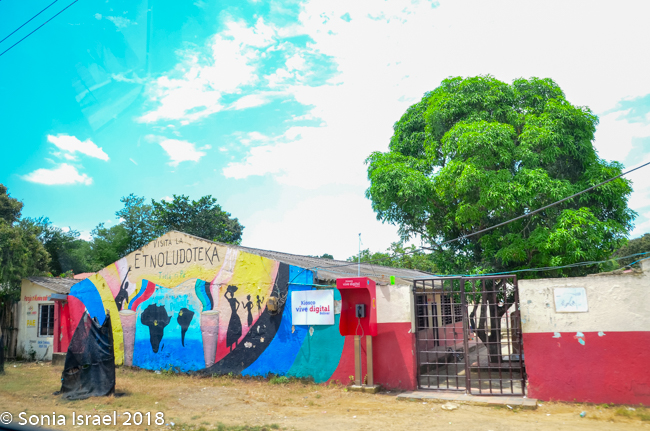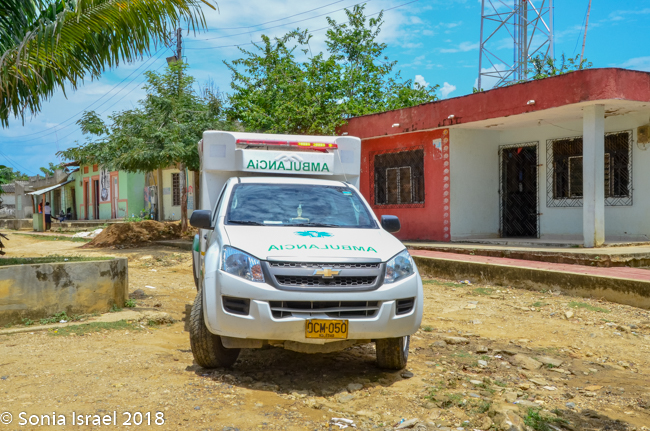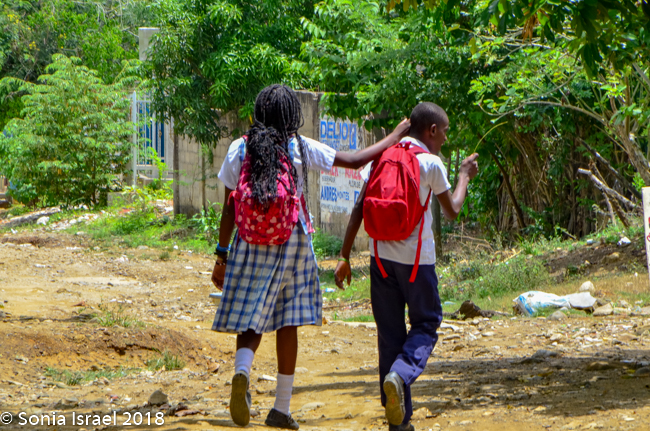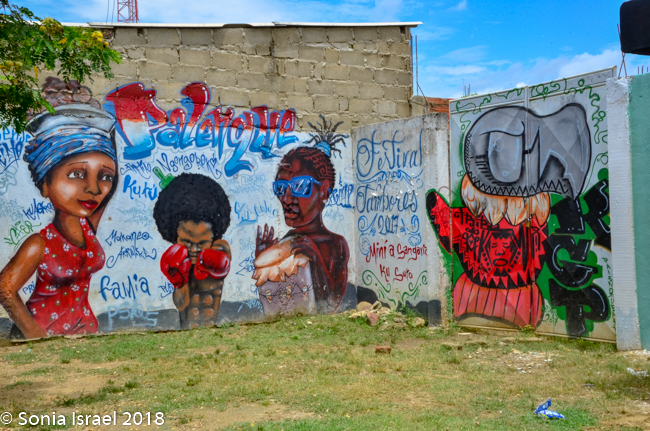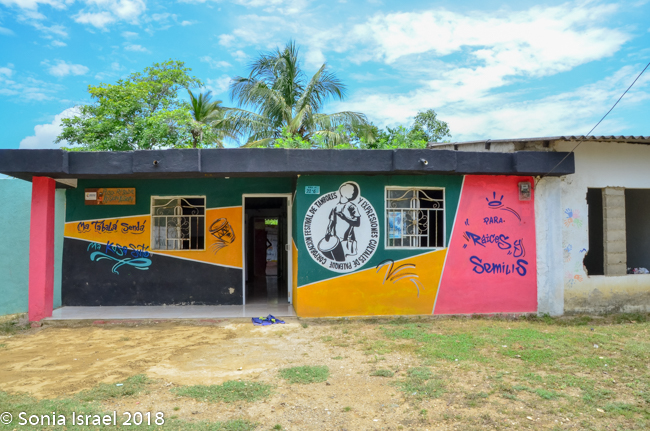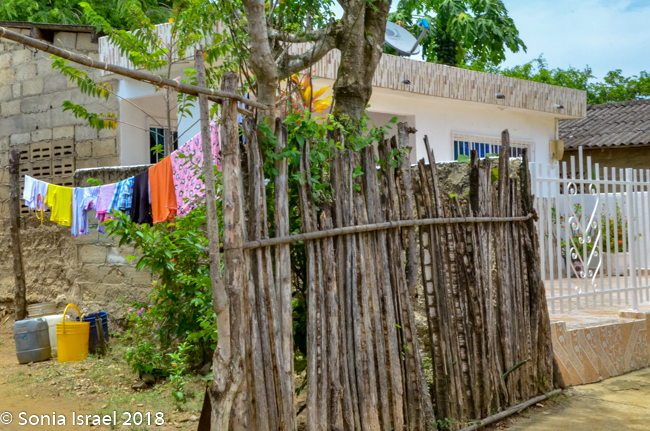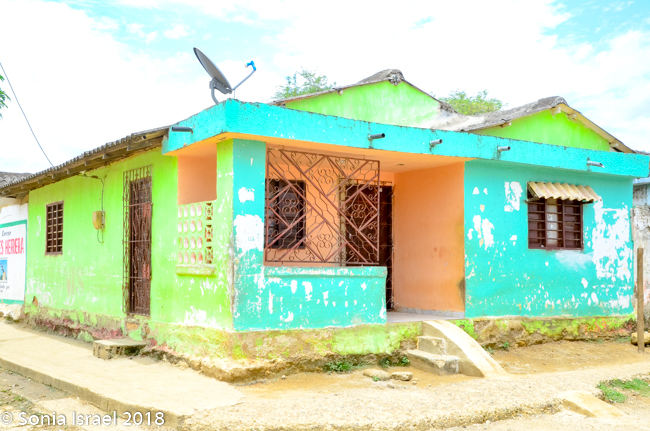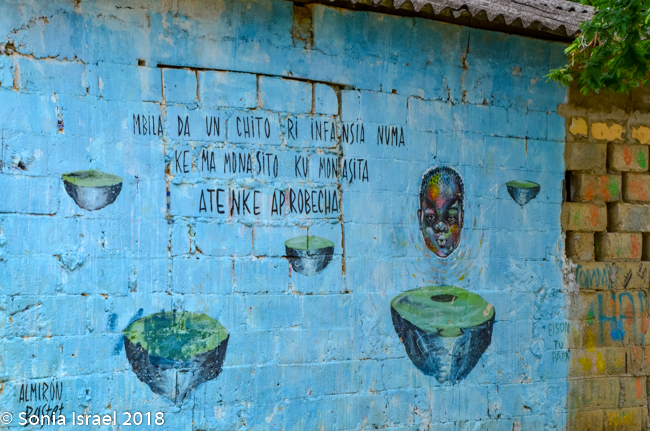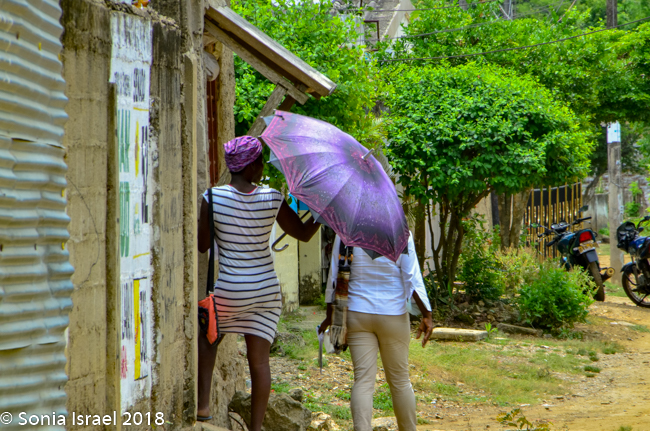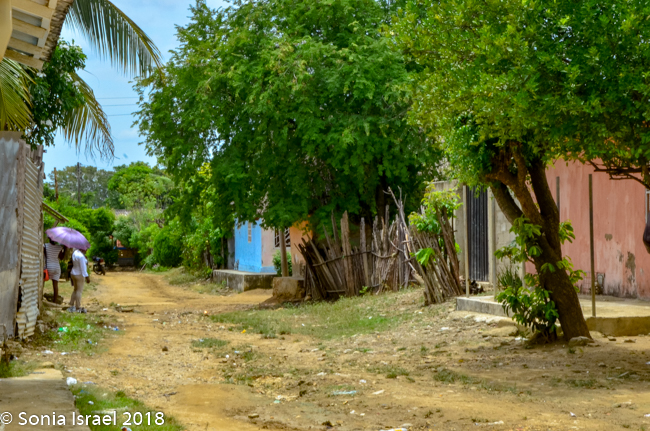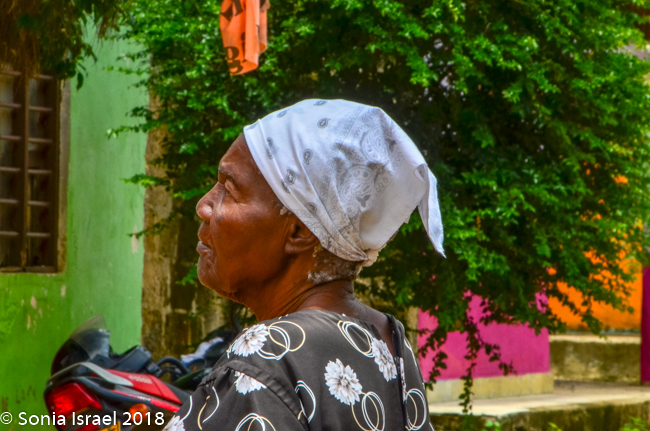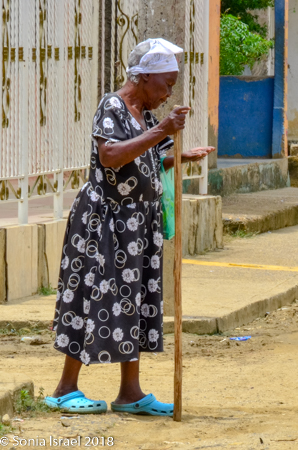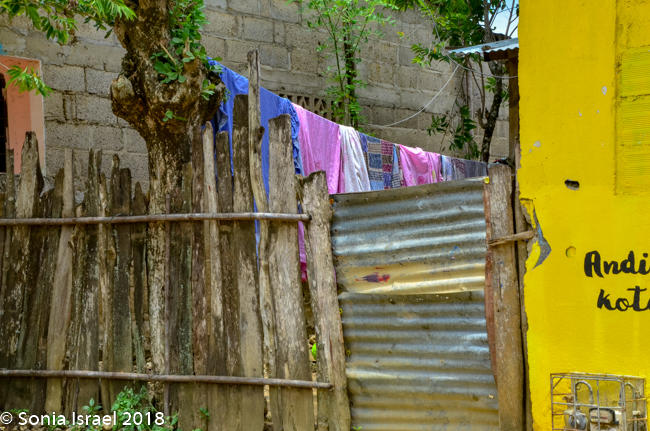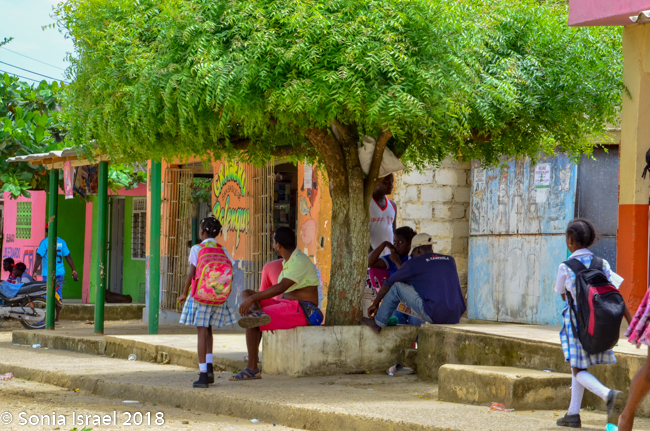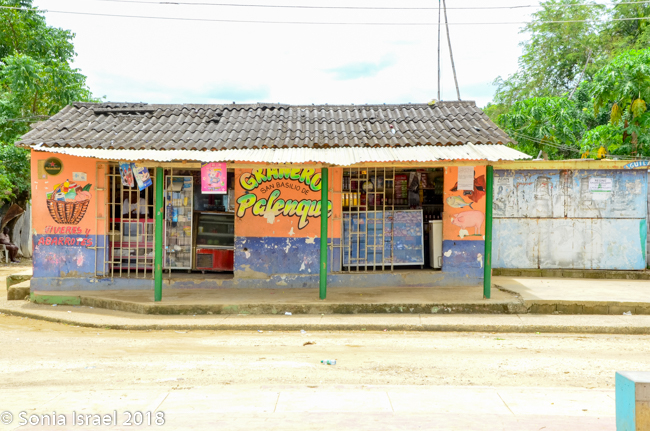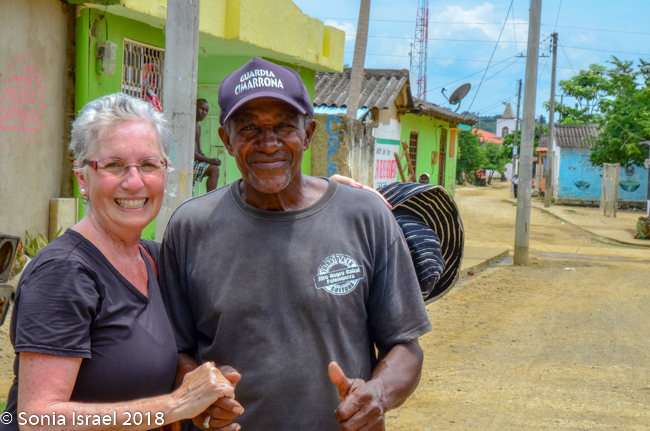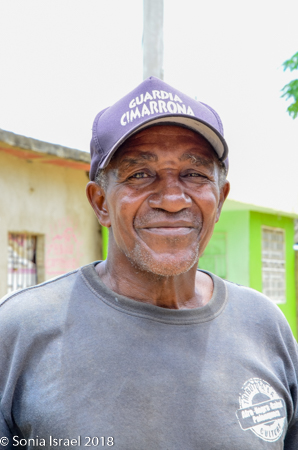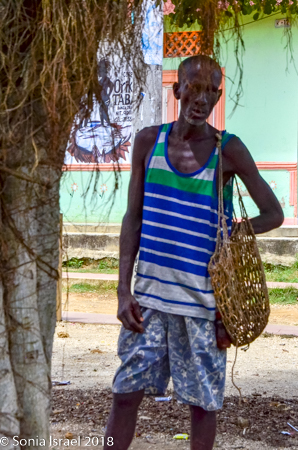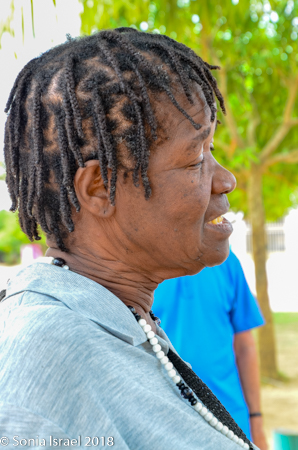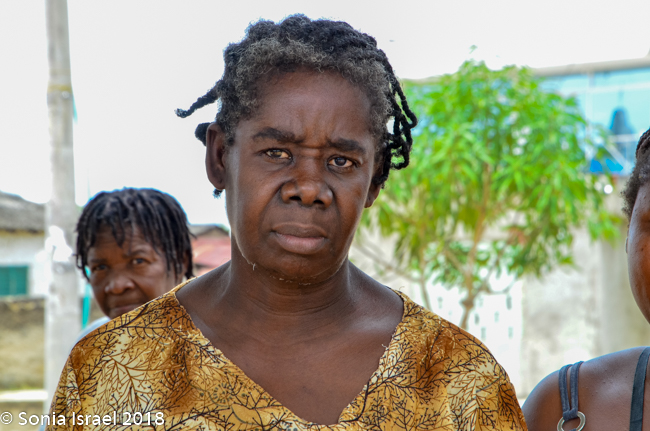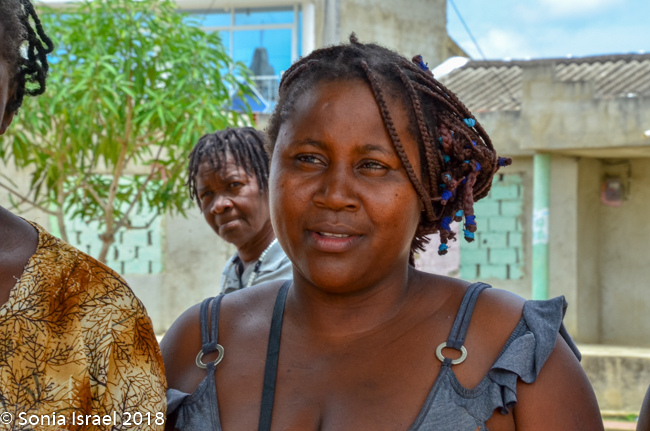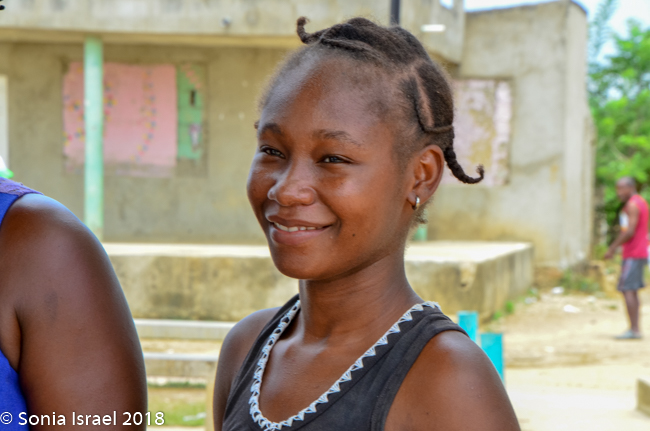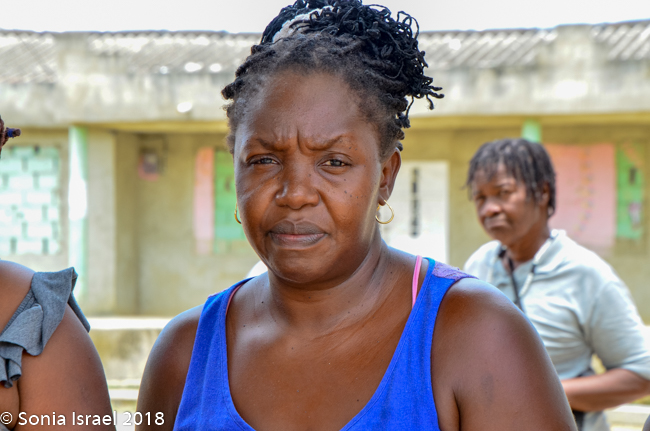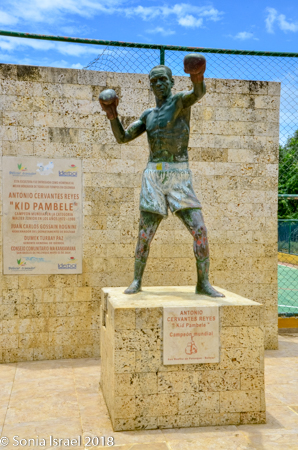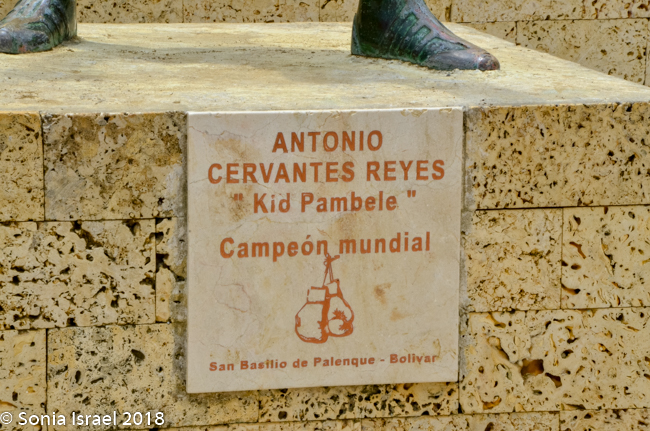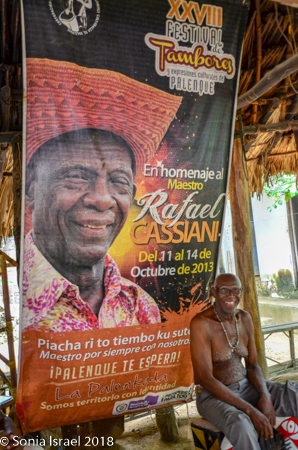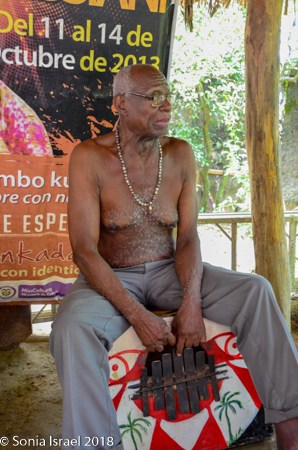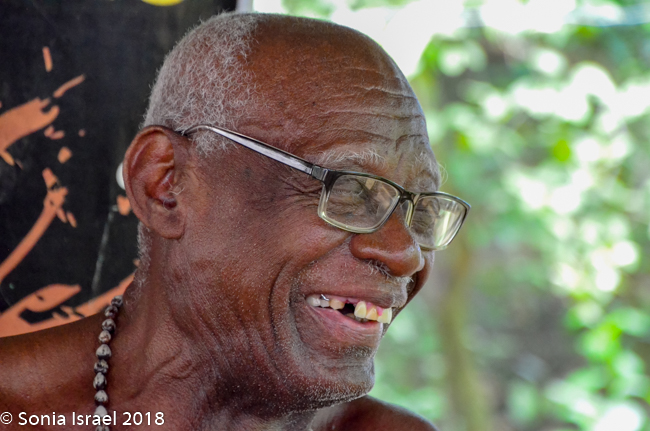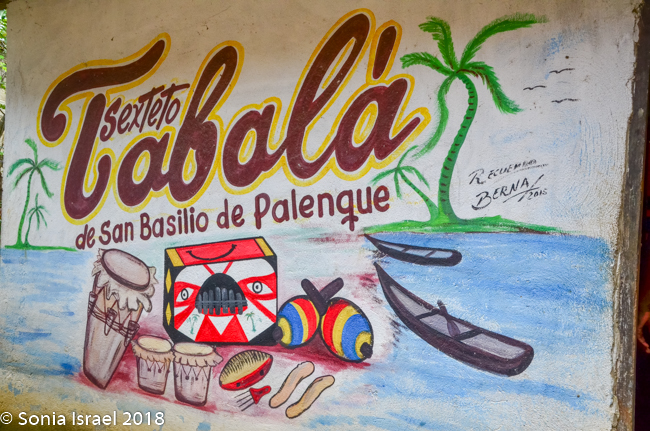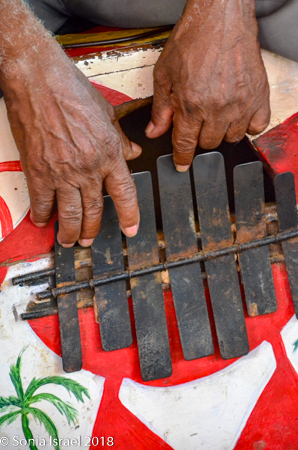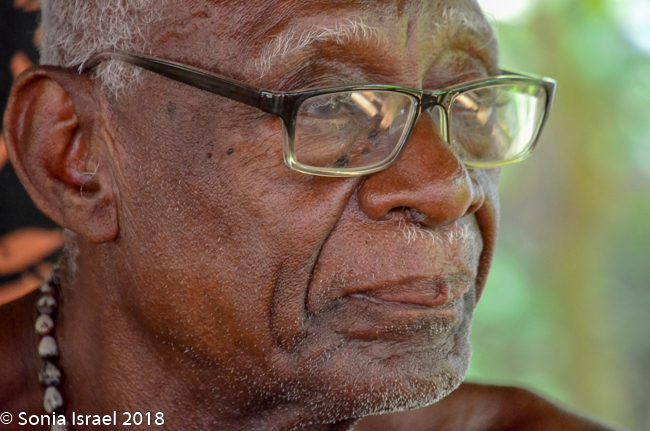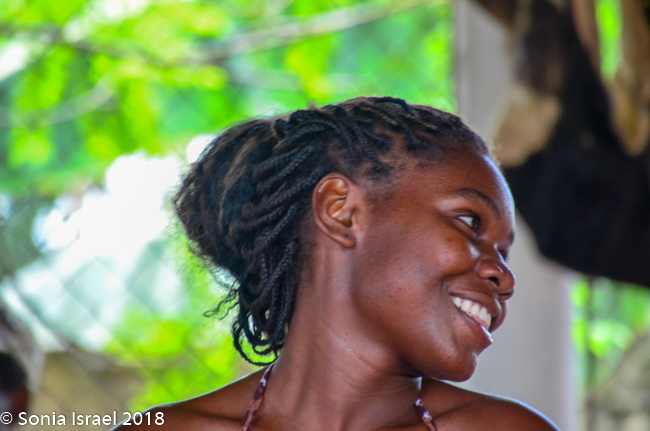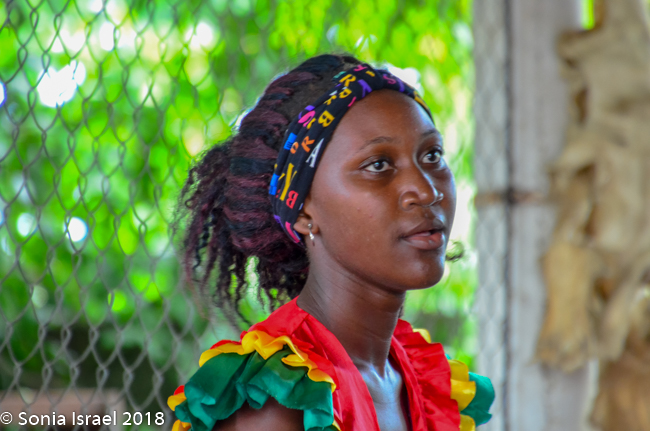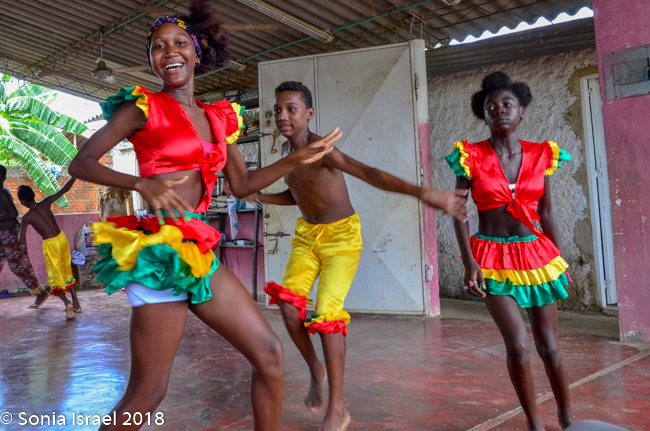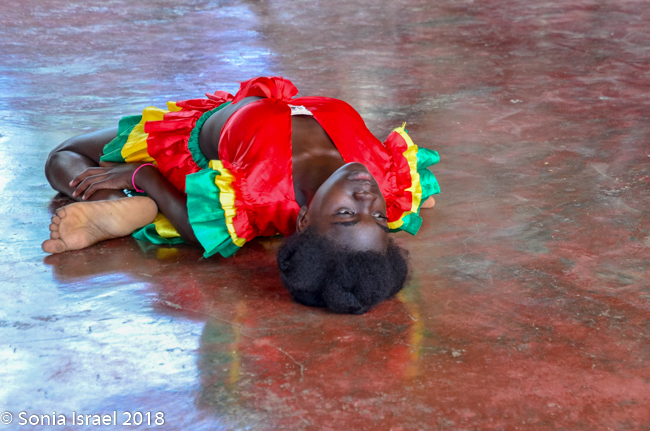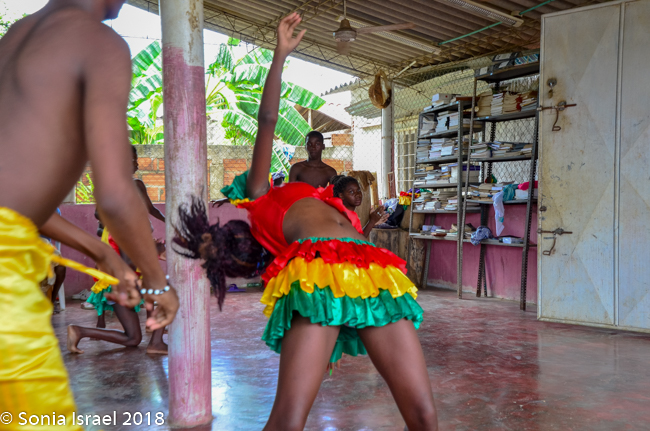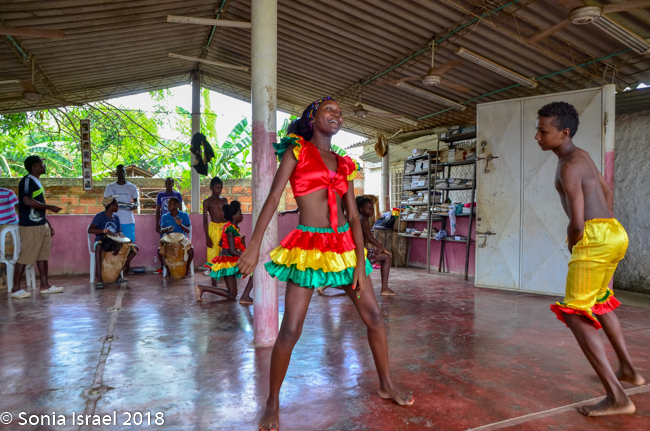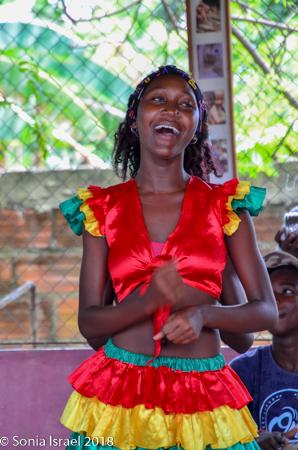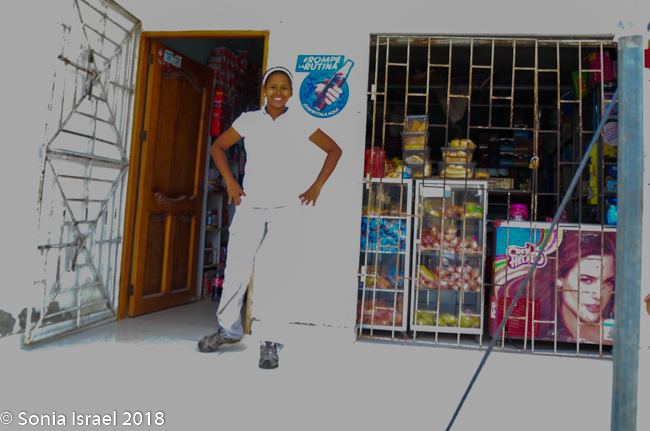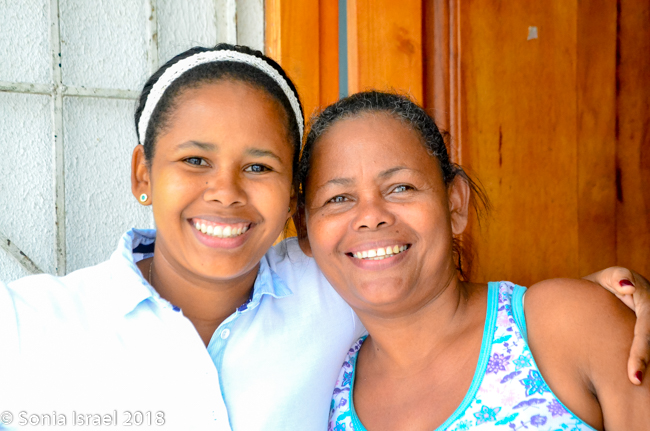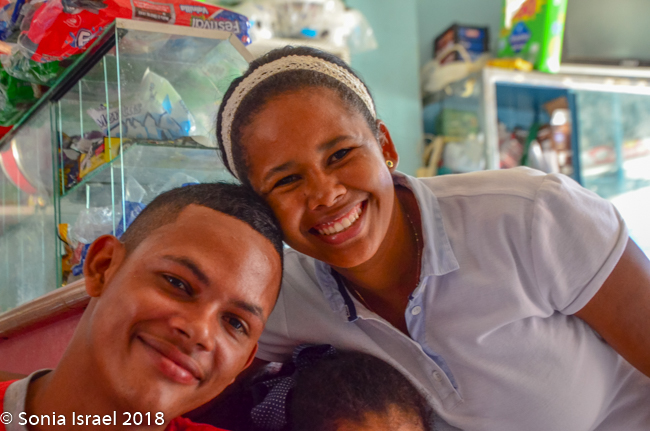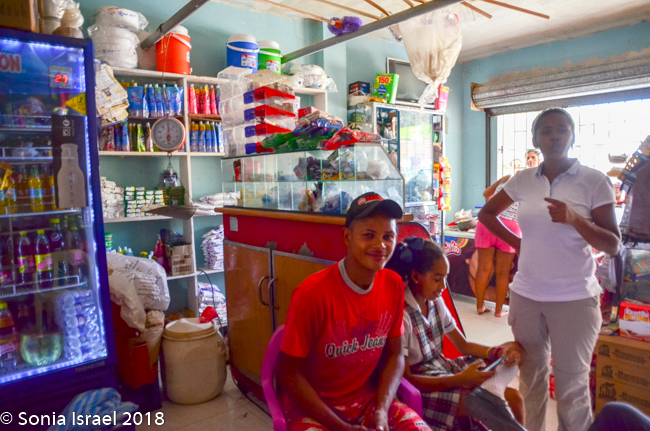Tuesday, July 24, 2018
We had just left the Castillo San Felipe de Barajas and were settled in the car for the 34-mile drive to Palenque. We passed lots of plantain trees, with the fruit covered in 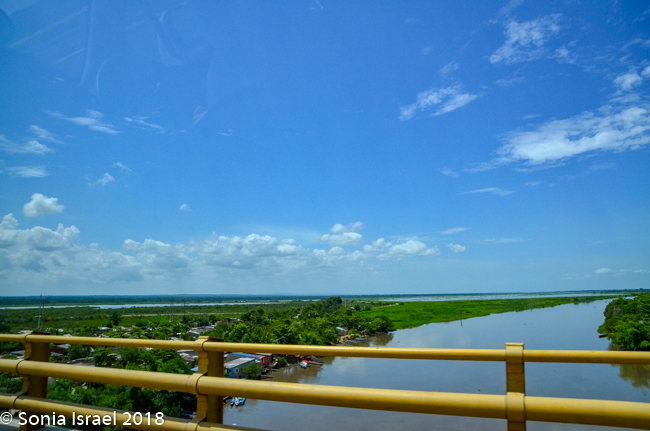 blue bags to protect them. The country side was beautiful, tropical and green.
blue bags to protect them. The country side was beautiful, tropical and green.
We passed what looked like a school field trip. The kids were all in white and red and waved frantically at us. We of course, waved right back.
We pulled off the road onto a dirt road, the entrance to Palenque.
Palenque
Palenque, also called San Basilio de Palenque, is really a small village nestled in the foothills of the Montes de Maria, a small mountain range just south of Cartagena. The word “palenque” means “walled city” and it was one of many walled cities founded by runaway African slaves during the 17th century. The “walled city” refers to the circular walls made of tall sticks used to protect the villagers from the Spaniards. Palenque therefore came to mean resistance and isolation that helped preserve Palenque’s unique culture, such as its African-descendant language. But the only village that survived and is still in existence was San Basilio de Palenque, although it is no longer walled.
Today Palenque is a village of about 3,000-4,000 (depending on who you ask). Many young adults from here go to the university in Cartagena and never come back so the population is dwindling. The men traditionally are farmers, the women go to town to sell fruit and the grandparents take care of the children.
Since 2005, it is listed as a UNESCO Masterpiece of the Oral and Intangible Heritage of Humanity.
Why did Palenque survive when the others did not? San Basilio was surrounded by a small mountain range so it was easy for the villagers to see who was coming. They would communicate with drums when the Spaniards came down the mountain. Each time, the Spaniards found houses, which they burned down, but no people as the villagers all hid in the mountains. After the Spaniards would leave, the villagers would come back and rebuild their homes.
In 1691 it became the first free town in the Americas and the locals the first free men and women of the New World, the Palenqueros and Palenqueras.
How did this come about? Well, it is the story of Benkos Bioho.
Benkos Bioho
Benkos Bioho was a king in the Republic of Congo, back in the early 16th century. He was captured by the Spaniards, transported to Cartagena, and like his fellow Africans, to be sold into slavery. But his boat sank somewhere along the Magdalena river and he escaped, setting up an army with his fellow runaway slaves, and established the exile community of San Balisio de Palenque. Biohó also created an intelligence network, which helped to facilitate more escapes The king tried in vain to overcome Benko’s army, but continuously failed. So he gave up and signed a peach treaty which gave the people of Palenque their freedom. Unfortunately, the king really couldn’t be trusted, and in 1621 Benkos was captured and hung. Finally, in 1691, the Spanish Crown issued an official Royal Decree freeing all Palenqueros from slavery once again – this time, for good.
A statue of Bioho stands in the main square in Palenque, showing him breaking free of his chains and reaching for his motherland, West Africa.
Freedom comes with Conditions
Freedom for Palenque came with conditions, as it often does. The Spaniards insisted that the villagers adopt Catholic names, practice Catholicism and renounce their religion. Everyone agreed in return for their liberty, but they never abided by them. While they gave up their African names and took Spanish names, the Black villagers kept their cultural practices and religion, albeit secretly. On Sundays, the church that the Spaniards built was empty. The Palenque African religion was more focused on spirits than on saints. We walked past the church on the main square and peeked in as the doors were locked. It was a bright white on the outside and inside. There were no pews, but rather white plastic garden chairs stacked up. It indeed did not look very used.
For centuries, Palenque existed in isolation. Only Blacks were permitted to enter the village. This helped them preserve their culture, language, music, religion and cuisine. Even today, the drum is the most important instrument in Palenquero music along with African dances. We would get to experience all this throughout the day.
The Palenqueras
As I mentioned, even with freedom, Palenque had its share of problems, part of which was that it was cut off from the rest of Cartagena and it was poor.
So the women of Palenque, called the Palenqueras, took matters into their own hands, deciding to exploit was they did have, that is, fruit.
Each morning the Palenqueras would pack their hand-woven baskets full of tropical fruit, put on their traditional African dresses, and walk the 34 miles, the long and exhausting journey into Cartagena. Standing in the hot sun, they would sell their fruit until it was all gone and then make the trek back home. They did this day in and day out. What they did not know was that they were slowly becoming a part of the history of Cartagena.
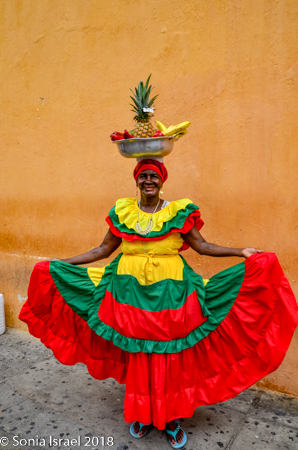 Today in Cartagena the women are still there, in their colorful African dresses with their fruit baskets on their heads. Some still sell their fruit. But many make their money posing for pictures. (Please see my post on Cartagena, Part 1). They have become one of Colombia’s biggest icons. Afterall, the Palenqueras today are direct descendants of the world’s first free African slaves, representing the best of human resistance, and becoming respected figures of courageous hard-working mothers who enhance the thriving Afro-Caribbean heritage.
Today in Cartagena the women are still there, in their colorful African dresses with their fruit baskets on their heads. Some still sell their fruit. But many make their money posing for pictures. (Please see my post on Cartagena, Part 1). They have become one of Colombia’s biggest icons. Afterall, the Palenqueras today are direct descendants of the world’s first free African slaves, representing the best of human resistance, and becoming respected figures of courageous hard-working mothers who enhance the thriving Afro-Caribbean heritage.
The Welcome Party
We drove into the village passing houses which were run down. The underdevelopment was clear. The roads were dirt, and mud and thatch houses stood between those made of brick. It felt like a sleepy town, until you looked more closely. It might be poor, yet it exuded a feeling of welcome and pride and a richness in culture. The inhabitants here are all black and still preserve their African customs and the only known Spanish-Bantu language spoken in the world, Palenquero. Palenque’s African-influenced funeral traditions, known as the lumbalu, have also been maintained and studied extensively by historians and anthropologists. Many of the oral and musical traditions have roots in Palenque’s African past. It is a piece of Africa in America.
We pulled up next to the main square, and as we got out of the car, we were met by Danilo, our local guide, and greeted by two young men putting on a welcome concert for us, just next to the sign for Palenque. One, the older one aged 30, wore a red t-shirt and blue genes and was playing the traditional drum, called Alegre, which means happy. He told us that he got his very first instrument at age 5, a water container. Now he teaches others how to play their traditional African music. The younger one, 17 years old, wore a colorful shirt, like a Nike and shorts, and was also playing an Alegre as well as what looked like a long metal tube filled with beads which he would shake. They are very famous musicians performing all over the world. The younger one performed for President Obama at the White House. And here they were performing for us.
They played a few songs while we swayed in time to the music. Then they invited me to sit down at one of the Alegres. The older one beat the drum one time and motioned for me to do the same. I did. Then he beat it twice. I did the same. Then he slowly added more and more rhythm, more and more beats. And I kept up with him. By the end he was doing complicated rifts. And so did I. He looked at my with a big smile, held out his hand to shake mine, and had Vicky translate that I had done a great job, better than he had ever seen a tourist do.
They played some more and Danilo and I danced to their music. Great beats. Great sounds.
Champeta
This music has a name. Champeta. Champeta refers not just to the music, but also to the culture whose history is marked by slavery. It is a combination of salsa and raggae and more. It was described as, “In champeta music the rhythmic base dominates over the melodic and harmonic lines, producing a music easy to dance to and marked by its strength and plasticity.” And it was indeed very dance-able. We heard it when we first arrived. And we would hear it over and over throughout the day.
Danilo
Danilo was a tall, imposing man, in sneakers, an orange shirt and the traditional Colombian woven straw hat. He is the spokesman for the town and would be our tour guide here in Palenque. But he spoke no English, so Vicky was our translator. First it was time for lunch. Danilo welcomed us into his home, just across the street from the main square. Dogs were running around everywhere. And cats. His home was painted white and yellow on the outside and a bright orange on the inside. The entrance steps were broken, but the welcome was genuine.
- Danilo and Vicky
Danilo lives here with his son, his daughter and his 87 year-old father. He has had three wives, but none at the moment. Bigamy is common here and some women don’t particularly care for it. No surprise.
We were seated in the main room, next to the kitchen. Danilo started by showing us large photographs of scenes of Palenque, then and now.
He pulled out a bottle of home-made whiskey for a toast and poured some for us in carved gourds. And then of course, coffee. Really good coffee.
And he taught us the four main principles of Palenque and of the Palenque culture. I tried to capture as much as I could.
Music
The first was music. You have music in life and in death. When we are happy, we dance. So working with music helps us forget our problems. Music is the way to communicate with the dead. At funerals there is music because the soul is going to Africa, so they aren’t really sad. The dead are dressed in white and placed in the center of house. The family walks around the body and spends nine nights praying. Why nine? Because they spent nine months in their mother’s belly.
Language
The second is language. As a result of their isolation, Palenque ended up developing a unique language, Palenquero, a form of Bantu made up of four dialects. including African, Spanish and Portuguese. It is spoken by about half the villagers although almost all of them can understand it. For hundreds of years the Palenquero language was used as a means of secret communication between slaves, essentially a weapon of resistance and a source of cultural identity. Today it is only spoken by those in Palenque and is considered the only Spanish-Creole language still spoken in the world. It was not taught in schools but passed down orally. Although the government built them a school in 1965, only Spanish was taught there. In th 1960s, nuns came to teach in the village but it was only in 1982 that they got teachers who could teach Bantu.
We learned a few words. Kumina meaning food. Changama, woman. Kumo bo ata, hello, how are you?
Herbal Medicine
The third was natural herbal medicine. Men and women can both be healers. The African slaves brought seeds which they hid in their hair. A healer will recruit others and teach them about the herbs. If they have minor illness, like a cough or a stomach ache, it is healed in the village. If that doesn’t work, or if it is more serious, they go to a Western doctor. There is a clinic in the village. Years ago, all babies were born in the village at home, but now it is not legally allowed, especially for the first child. They go to Cartagena, either a few weeks before the due date, or by ambulance. The second child can be born at home only if it is a natural birth and not a Caesarian.
African Rituals
The fourth was the African rituals. They have 5 gods. But of course the Spaniards forced them to convert. They have a church that was built by missionaries in 1713. The missionaries had an agreement not to report them so they continued to pray at home or at the river. They did not have statues of their gods, but they did sacrifice animals.
Lunch
In the meantime, his daughter was preparing lunch for us. On my way to use their bathroom, which was right off the kitchen, I saw her cooking coconut rice and Angle face fish, traditional West African-Caribbean fusion food. And beautiful vegetables for a salad.
They pulled out some folding tables and set them up for us the five of us. Andy and me, Vicky, our driver, and Danilo. The red snapper was served whole wrapped in leaves which served as our plates. There were vegetables and coconut rice, of course. It was all so fresh, so delicious and beautifully presented.
Walking off lunch
After lunch it was time for a walk through the village. There was lots of street art including art that embodied the pride in being Black. The flag of Palenque is black, blue and green, clearly signifying being Black, the sky and the green of the land. There were kids in their school uniforms. There were little kids just hanging out. There were old women slowly walking around. Danilo of course knew everyone so the walk was slow as he stopped to greet each one. And introduce us. We ran into the mayor who posed for a picture with us. Vicky ran into an old friend who was zipping by on his motorcycle. The village was run down as there still is not enough income. But everyone was friendly. Everyone was welcoming.
Braids
There was a group of women hanging around the square. I asked if I could take their pictures. I was particularly enthralled by their braids. Braids in Palenque are more than an African tradition. In the 16th century the slaves used hair-braiding to create maps to guide them and fellow slaves to Palenque, that is, to freedom. All agreed to having their pictures taken, although not all smiled. But one wanted money for it. I did not take her picture. The few tourists that come here are spoiling the traditions. Vicky said she hoped it would not change too much.
Kid Pambelé
Palenque is the birthplace of some of Colombia’s finest boxers. The most famous is Antonio ‘Kid Pambelé’ Cervantes a two-time world Jr. Welterweight champion. Antonio grew up selling black market cigarettes and polishing shoes in Cartagena to make ends meet. But then, within a few years, he became one of the world’s most successful boxers. He won Colombia’s first world title in 1972 and defended his Junior Welterweight title 16 times. But he also gave back to his hometown of Palenque. He helped the village get water and electricity. All these things made him a hero and worthy of the statue of him in town, standing proudly in a fighting stance overlooking where he was born and raised.
Rafael Cassiani
We made our way to the next stop, to meet Maestro Rafael Cassiani. The Maestro is a famous musician who was one of the first to give birth to the music genre champeta which I described above. He is also considered one of Colombia’s finest musicians. We walked through his house to the back yard where he was sitting, under a large, large poster of him, waiting for us. He wore long pants, yellow Crocs, and was bare-chested except for a long beaded necklace. Between his legs was a variation of a kalimba or mbira (UM-beer-ra), a square box with a hole in the front and metal keys. After introductions and hand shaking, he began strumming the metal keys making beautiful sounds. The hole in the box created almost a warbly effect. He told us, with Danilo translating, about his musical career. And it was a long career as he is now 84 years old. He told us that his instruments are all African and handmade. His music is original. And he has traveled the world performing.
After finishing his mini-concert, he posed for pictures with us and invited me to try playing. Which of course I did.
Passing it on
Our musical education wasn’t over yet. We strolled down the street to a school dedicated to teaching the children of Palenque their music and their dance. A group of young adults were waiting for us in their traditional African dress. They set up two chairs for us in the large, almost gymnasium type room, and they began to dance. And dance. And dance. The shook their shoulders. The bent backwards onto the ground. The swung their hips. They were talented. And we sat and tapped our feet because you can’t sit still when listening to this music.
Towards the end of their performance, one girl came over to each of us and pulled us up onto the dance floor. And we got to dance with them.
Family
As we were driving back to Cartagena, Vicky suddenly shouted out, that’s my village! We were passing the village where she grew up, Arjona. I quickly said, “Let’s stop,” so our driver veered off as Vicky directed him to her mother’s store. We drove by lovely small homes and stopped in front of her mom’s small grocery store, where her mother works every single day, no days off. The store had some of everything in it, just what a village needs. Groceries. Fruit. Household products. Vicky’s brother was also there as he helps in the shop.
Vicky looks just like her mother – both beautiful. It made them both so happy to see each other unexpectedly, and it made us happy to see them together. Family is important in Colombia. Just as it should be.
